An Explanation of the Techniques of Byzantine Iconography
ICONOGRAPHY IS THE OLDEST TRADITION of Christian sacred art, embodying the work of thousands of iconographers, many of whom were themselves saints. Unlike other approaches to painting, the creation of an icon does not begin in the artist's imagination. Rather, the iconographer's first work is to study how the subject at hand has been traditionally depicted in this rich artistic tradition.
Below is a video of how the icon "O Holy Night" was conceived and painted, and below that a step by step walkthrough of the stages in the creation of an icon, in this case of St. John the Baptist.
In creating a new icon, our iconographer begins by searching his collection of books on icons, gathering samples of icons of the new subject (like the icon of St. John the Baptist that you see in this page's photos) and other similar subjects, to find the traditional depiction. 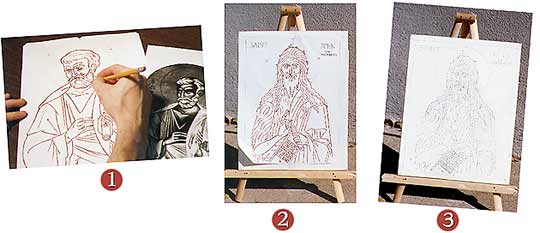
After he has studied these samples, compared the elements in the icons, and chosen what he thinks are the best (fig. 1), the iconographer uses pencil and paper to create a preliminary sketch called a skelion (fig. 2). Using graphite paper, he then transfers the drawing onto a prepared, gessoed board (fig. 3).
Then he etches the lines of the icon into the gesso using a stylus (a thick needle embedded in a small wooden dowel) (fig. 4). In this way the lines of the figure will remain visible as he paints.
Although in other schools of painting the artist commonly paints on canvas, the iconographer usually paints on a wooden board. This is because the traditional medium for iconography is egg tempera, which becomes inflexible after it dries and consequently needs to be applied to a firm surface to avoid cracking. Monastery Icons uses acrylic paints that closely duplicate the qualities and appearance of egg tempera.
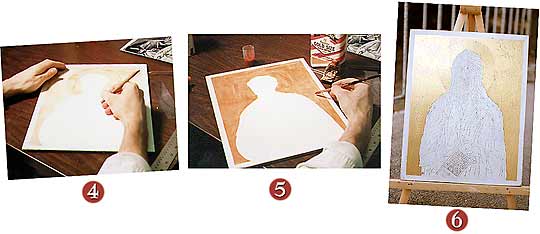 The board is usually prepared with several coats of white gesso (a thick preparation of white pigment in an adhesive base). Since the paints traditionally used in iconography are to some degree translucent, light actually passes through the paint of the finished icon and then illuminates or brightens the colors of the paint by reflecting off the white background of the board.
The board is usually prepared with several coats of white gesso (a thick preparation of white pigment in an adhesive base). Since the paints traditionally used in iconography are to some degree translucent, light actually passes through the paint of the finished icon and then illuminates or brightens the colors of the paint by reflecting off the white background of the board.
Most of Monastery Icons feature a painted gold-colored background. However, when the iconographer chooses to use a gold-leaf background, he begins by applying a coat of size (fig. 5) on the background area. When the size is slightly tacky, he applies sheets of gold leaf to the background area, and then burnishes the leaf to a deep shine (fig. 6).
After painting the gold background (symbolic of the heavenly world), the artist paints the halo or nimbus. This is done by scribing the circle with a compass and a pen nib dipped in bright red paint (fig. 7).
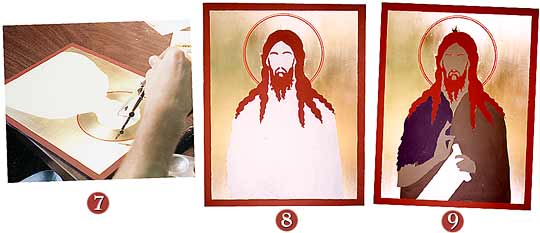 The iconographer applies the paint in layers, beginning with the darker, underlying colors (fig. 8). He begins the flesh areas with an olive green base coat, over which he will paint lighter colors of transluscent paint. In this way the underlying greenish tinge will create shadows and depth (fig. 9).
The iconographer applies the paint in layers, beginning with the darker, underlying colors (fig. 8). He begins the flesh areas with an olive green base coat, over which he will paint lighter colors of transluscent paint. In this way the underlying greenish tinge will create shadows and depth (fig. 9).
Next, he applies a basic flesh coat over the green base coat, following by increasingly lighter tints of the flesh color and then the darker outlines and details are executed (fig. 10). The subject's clothing and other elements are also "built" in a similar manner, usually beginning with the broad, dark background colors, and then adding the lighter colors and the details over this background (fig. 11).
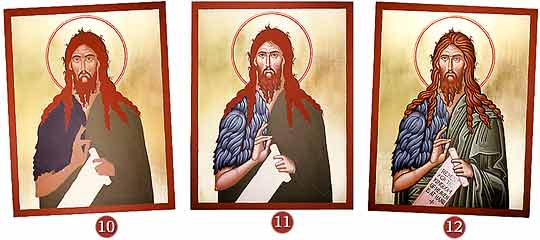 With the lettering of Saint John's scroll (fig. 12), the work is complete... and we can proceed to make reproductions for you: photographing the icon, laminating and mounted the prints on wood, and carefully finishing them.
With the lettering of Saint John's scroll (fig. 12), the work is complete... and we can proceed to make reproductions for you: photographing the icon, laminating and mounted the prints on wood, and carefully finishing them.
We have hope you have enjoyed this short introduction to the physical techniques of iconography. But iconography is much more than a particular technique or even style of rendering form in paint. As the great modern Byzantine iconographer Photios Kontoglou wrote, "The art of the icon painter is above all a sacred activity...Its style is entirely different from that of all the schools of secular painting. It does not have its aim to reproduce a saint or an incident from the Gospels, but to express them mystically, to impart to them a spiritual character...to represent the saint as he is in the heavenly kingdom, as he is in eternity."
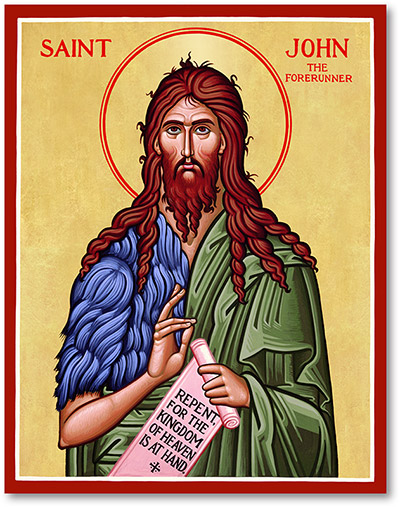
You can purchase this icon of Saint John the Baptist here.
You can discover more about the world of iconography at another page in this site, The Symbolism and History of Iconography. You can also see how an icon is painted in time-lapse photography on our O Holy Night Video.